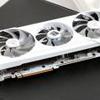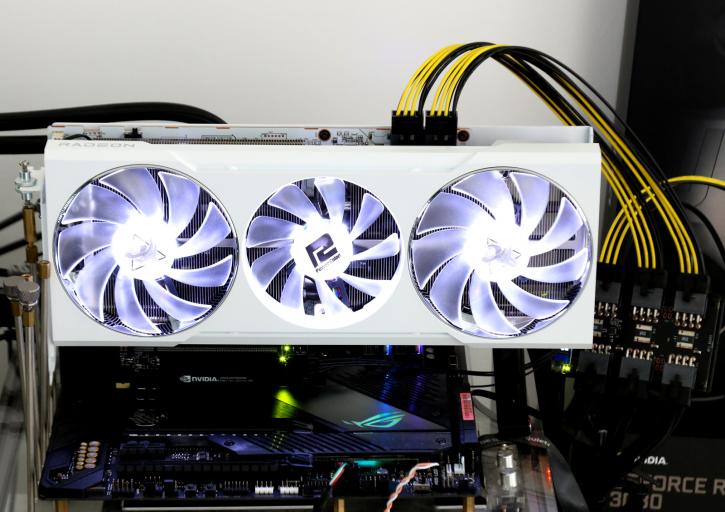Final words and conclusion
Final words
It's like a deja-vu, a card offering the same performance as the original Hellhound with some variation here and there. This card is offering close to reference performance, sometimes a notch faster, often a percent slower. Other than that, there are aesthetic tweaks going on, all in white, of course. PowerColor manages to offer a nice-looking product to the market. It's interesting to see that its power consumption under load was even a notch lower than reference, just under 200W. Overall the Radeon RX 6700 XT is a hip little card in that WQHD (2560x1440) resolution domain for gaming; however, very expensive. We've seen incredible price hikes in the past two years where mainstream series graphics cards have been repositioned as high-end once, with accompanying price levels. NVIDIA has started that trend, and where AMD always had a little more value to offer, this year, that tide has turned. It might be so that the reference RX 6700 XT sits close to RTX 3060 Ti and sometimes 3070 performance, but only in shading performance. Raytracing performance is just quite a bunch slower than the competition offers. I can also not apprehend that AMD still has not implemented any form of machine learning super-sampling dedicated in hardware, much like NVIDIA offers Tensor cores. For these two reasons (RT perf and lacking MLAA), we cast doubt as to why AMD is trying to justify a price of 479 USD as really the true competitor here is the RTX 3060 Ti with its 399 USD MSRP. NVIDIA introduced its Tensor cores back in the summer of 2018 (!). You can also argue that while the Infinity cache works most of the time, it's designed to be a workaround to fill a flaw in the choice of memory type (GDDR6 opposed to GDDR6X), the current AMD GPUs are memory bandwidth deprived, even with GDDR6 at 16 Gbps, but especially running over a 192-bit wide memory bus.
Cooling & acoustic
Powercolor has a very decent performing cooling design. Expect under 60 Degrees C game load ranges depending on the internal airflow inside your chassis. Acoustics wise the product remains fairly silent, reaching the 36~37 DBa marker. However, the fans do ramp up and down quite a bit, which can be heard. FLIR imaging shows the card is hardly bleeding heat. Overall, we're delighted with what we observed.
Energy consumption
Heat output and energy consumption are closely related to each other, as (graphics) processors and heat can be perceived as a 1:1 state; 250 Watts in energy consumption approaches close to 250 Watts in heat as output. This is the basis of TDP. AMD is listing the card at 230W, which is okay at best for a graphics card in the year 2021. We measure the typical gaming power consumption of the card just under 200 Watt, with minor spikes towards roughly 215W. Idle power consumption sits at 17 Watts (TBP - total board power).
Coil whine
Compared to the reference Radeon RX 6700 XT, the Powercolor card exhibits a bit more coil squeal. It's at a level you can hardly hear it. In a closed chassis, that noise would fade away in the background. However, with an open chassis, you can hear coil whine/squeal. Graphics cards all make this in some form, especially at higher framerates; this can be perceived.
Pricing
Worrying. We've asked for an MSRP; however, Powercolor will not give it. We all hope it's at the 550 USD marker for the White edition, however likely it'll end up at over 800 USD with the current repulsive state of the market. I raised enough concern about pricing in general of this product series, though.
Tweaking
The hellhound is a non-OC SKU, which means it'll run into three restrictions;
- Maximum memory bandwidth. You can add it by dialing up the memory frequency towards 17.2 Gbps; AMD enforces limits on the memory subsystem, limiting your GDDR6 memory that maximum overclock.
- The maximum clock frequency for tweaking is 2800 MHz
- More limitation on the power budget, 15% tweaking is still there, but the max base power is lower at ~200W, so add 15% and max ~230W is what you can assign as power budget.
The clock frequency remains spectacular; after selecting 2800 MHz, the GPU was settling at 2700~2750MHz. Combined with a slightly increased power limiter, you'll have gained a strict up to 5% additional performance. This was similar to the dark model.
Conclusion
Very little is new with the Hellhound RX 6700 XT. This release was all about the Spectral White-colored version, and granted; it does look spectacular. However, a white-colored graphics card be difficult to combine with the current dark trend of PC components. Keep that in mind, as aesthetics should be based on the entire build, not just one component. The hellhound is a more normal-looking and performing product, and if the product sticks close to MSRP, we would certainly appreciate that (albeit general, the AMD MSRP already is out of my comfort zone, though). The card allows you to tweak a notch extra perf, albeit being more restricted. The looks are sophisticated in the white design. The fans radiate one color, white, which you can turn off with a small switch. You'll retrieve a reference-performing product in that WQHD range at very pleasing temperatures. Overall it's a lovely Full HD and Quad HD card with abilities at Ultra HD as well. Raytracing performance on this generation RDNA2 cards is a bit more mediocre, and of course, AMD lacks something DLSS, big time. It has nothing to do with TUL/PowerColor, though, and this round, AMD priced the card series starting at close to 500~550 bucks for something intended in the WQHD monitor range. While we can recommend the card as what Powercolor offers, we remain to have a tough time justifying the overall price level.
Sign up to receive a notification when we publish a new article.
Or go back to Guru3D's front page.
- Hilbert, LOAD"*",8,1.


